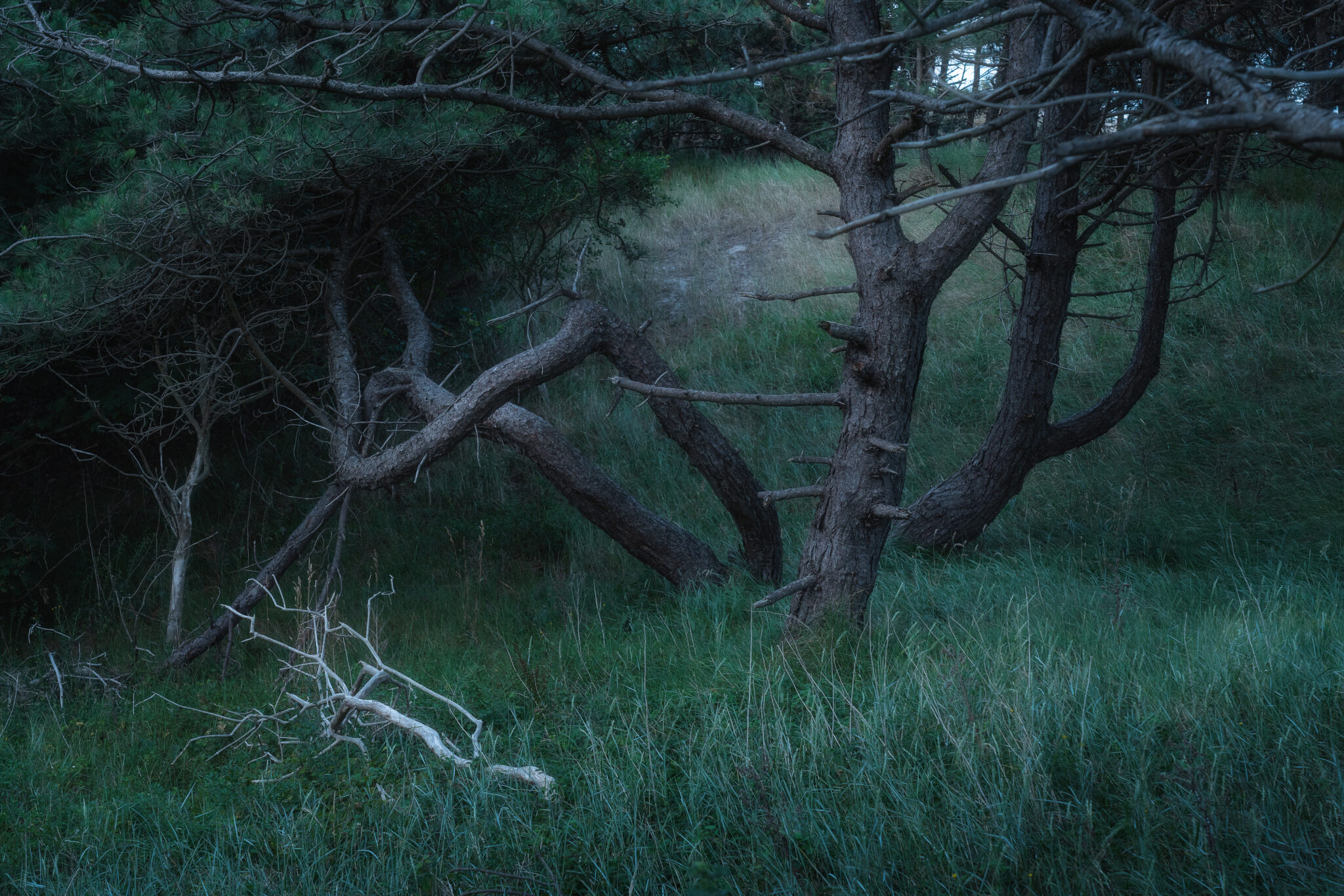
You can see the VLOG to the BLOG at the bottom of the page or you can reach it via this button:
Gear:
Sony a7IV
Sony FE 2.8/16–35 mm GM
Sony FE 4/24–105 mm G
Sony FE 100–400 mm GM
DJI Mini 3 Pro
Before I went to bed, I had a quick chat with my father, my travel companion. We’re still going to Frankfurt as planned and will see what we can do on the spot. So we lie down again for a bit. Our train leaves at 4am. I sleep badly. In the night I receive an email from the airline. Instead of Frankfurt — Paris — Vágar (Faroe Islands), we fly at the same time to Amsterdam and from there via Edingburgh to Vágar. At least that’s good. We don’t arrive until late in the evening, but at least we get there. I roll over and try to get some more sleep.
The alarm clock rings — it feels like just a few minutes later. I rewind my program. I say goodbye to my wife and sleeping daughter and get into the car to drive to the station. Suddenly the thought occurred to me. My father doesn’t have a passport. He can’t fly to Edinburgh. We spoke to the ground staff at the counter in Frankfurt. “You’re right”, was the ground staff’s reply, “but that’s your problem”.
That made my pulse race. “No, that’s not our problem! We’ve booked the flights so that we stay within the EU, so we only need an ID card. Your change came at such short notice. So it’s their problem!”. The ground staff wanted to make life easy for themselves and said: “Then just fly tomorrow.”
But we didn’t want to accept that and persisted. “No, we’re flying today. We’ve already paid for the train here, the rental car, the apartment for today and booked the flight today!Think of a way to get us to the Faroe Islands!”.We went back and forth for a while until he actually came up with something.
He rebooks us onto Lufthansa/SAS. Our flight leaves for Hamburg in just under an hour, then via Koppenhagen to Vágar.Two changeover times of less than 30 minutes, but we’ll be on the Faroe Islands earlier than planned.Will we make it?And what about our suitcases?
But it went well, partly because the same plane that took us to Koppenhagen flew on to the Faroe Islands. We were lucky.And so we were able to set off on our first tour on the very first evening.
A quick look at the weather maps. “If the weather is going to be good today, it should be in Saksun,” I said to my father. Then we got into the car and set off. The drive to Saksun through the Saksunardalur valley is an experience in itself. Which is why we stopped briefly for a few photos.
Saksun is secluded on the west coast in the north of Streymoy — one of the main islands of the Faroe Islands. Saksun is surrounded by mountains that are almost 800 meters high by Faroese standards. A popular hiking trail, based on the paths of the ancient Faroese, leads from Saksun to Tjornuvik. The village church, which immediately catches the eye, originally stood in Tjornuvik and was brought here via the aforementioned hiking trail.
Anyone visiting the Faroe Islands should definitely pay a visit to Saksun. The sandy beach, which was washed up by a storm, is unique in the Faroe Islands. At low tide, it is even possible to walk through the fjord to the open sea.
Of particular photographic interest are the picturesque stone houses with their green grass roofs and the waterfall that cascades down into the valley after rain. It is a particular challenge to capture the peat houses of the historic farm and the waterfall in one picture with a wide-angle lens. To do this, you have to stand in the waterfall with your camera, so be careful as it can be very slippery!
Photographically, the evening was extremely successful. The stress of the journey was almost forgotten. The Faroe Islands delivered what we had expected.
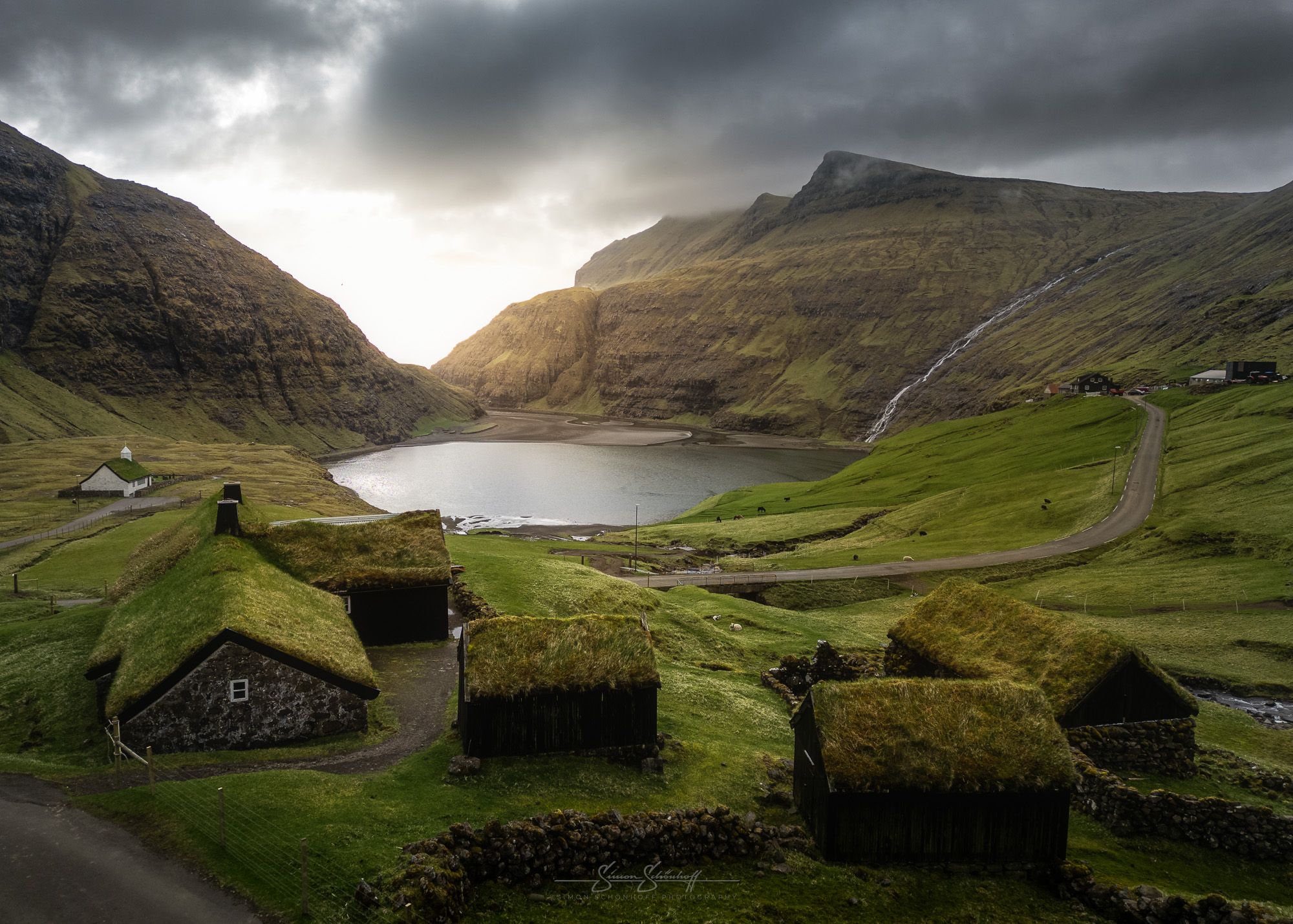
It was my first time on the Faroe Islands. So I relied completely on the weather forecast and it was so … well. During the trip, I checked the weather maps in the evenings and mornings and then decided more or less spontaneously where to go and planned the tours.
But over the next few days, I realized that, in addition to suitable motifs and weather maps, you also need to have the peculiarities of the Faroe Islands on your radar. In the center and between the fjords, but also at higher altitudes, low-hanging clouds were sometimes very persistent. We had comparatively few windy days. The saying wait 5 minutes if you don’t like the weather didn’t apply to our trip.
The next morning was to bring the decision about our next day’s tour. The forecast was for rain and low clouds in the morning. However, they shouldn’t be too low. There was also a bit more wind than the previous evening. It should clear up a bit across the whole island towards the afternoon.
The plan was made. Today it was going to be the north of the main island of Esturoy. The first spot on the way was the view of the largest waterfall on the Faroe Islands: Fossa. Fossa itself is located on the island of Streymoy and is very easy to reach because it is right next to the road.
Photos with a telephoto lens are possible from here. If the wind direction is right, the water is whipped upwards again. Unfortunately, even after waiting a while, this phenomenon did not occur this morning. Instead, the clouds lay on the plain above, which made for a beautiful atmosphere. I also waited for a car on the road so that the dimensions would be clear in the picture.
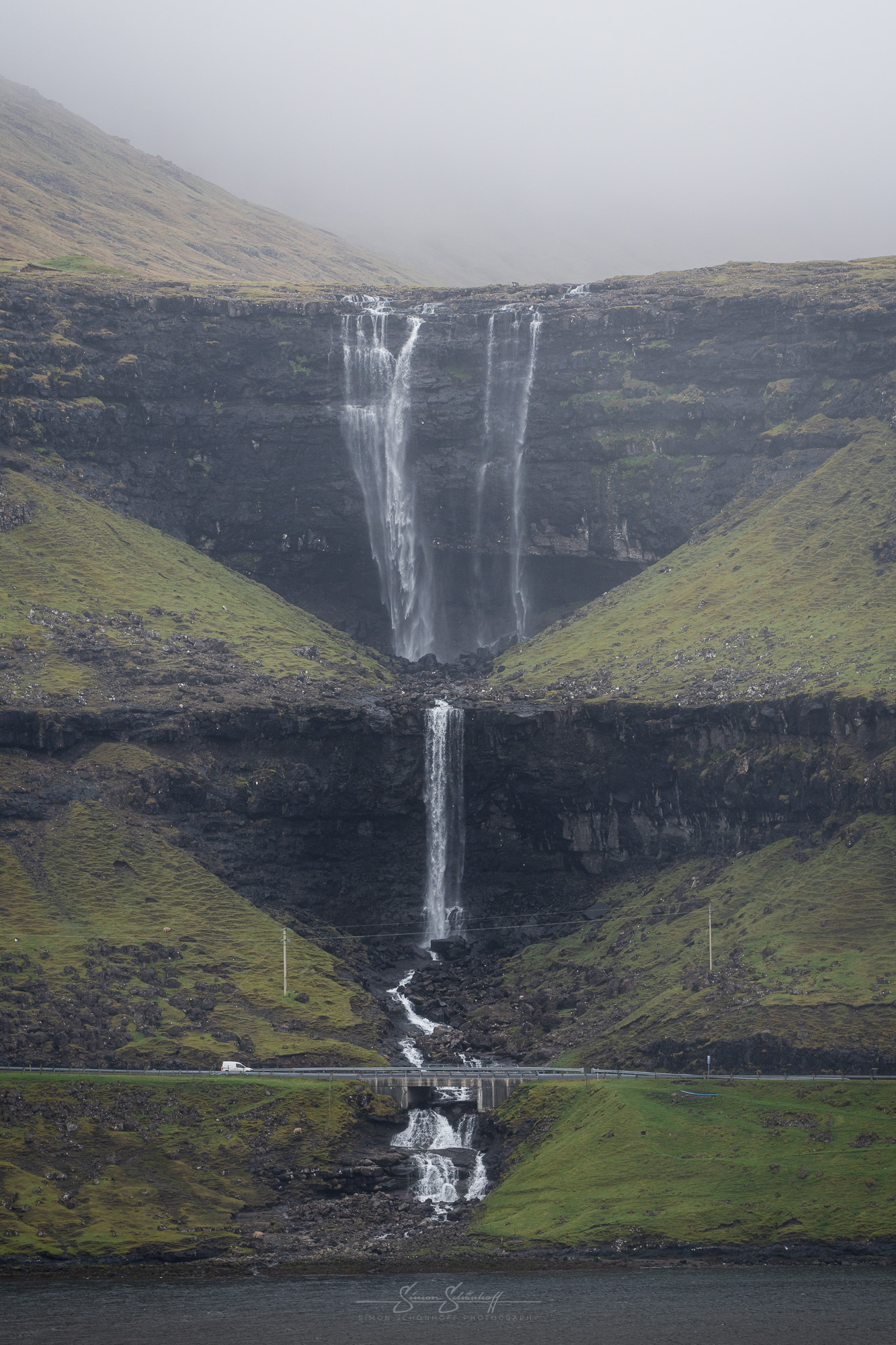
We continued on to Eiði. Where a soccer pitch was built close to the sea, almost directly between a lake and the waves of the sea. Today, the soccer pitch is only used as a camping site. If you walk along the coast, after a few minutes you reach a waterfall and rocky coast with endless possibilities for foregrounds.
The wind whipped rain and seawater into our faces, so microfiber cloths were used for the first time. Searching for composition, focusing, cleaning, taking photos. That’s how it went for the next few minutes.
The special challenge on site was the use of filters. Within seconds, they were full of water splashes. So cleaning was necessary. Constantly. Keeping your eyes open was also incredibly strenuous due to the wind.
If you are also planning to go here, be careful in wet conditions. The ground is incredibly slippery. A B‑motif from this point is a rock from “Risin og Kellingin”, which is visible from here. With the right foreground, this can also make a great picture.
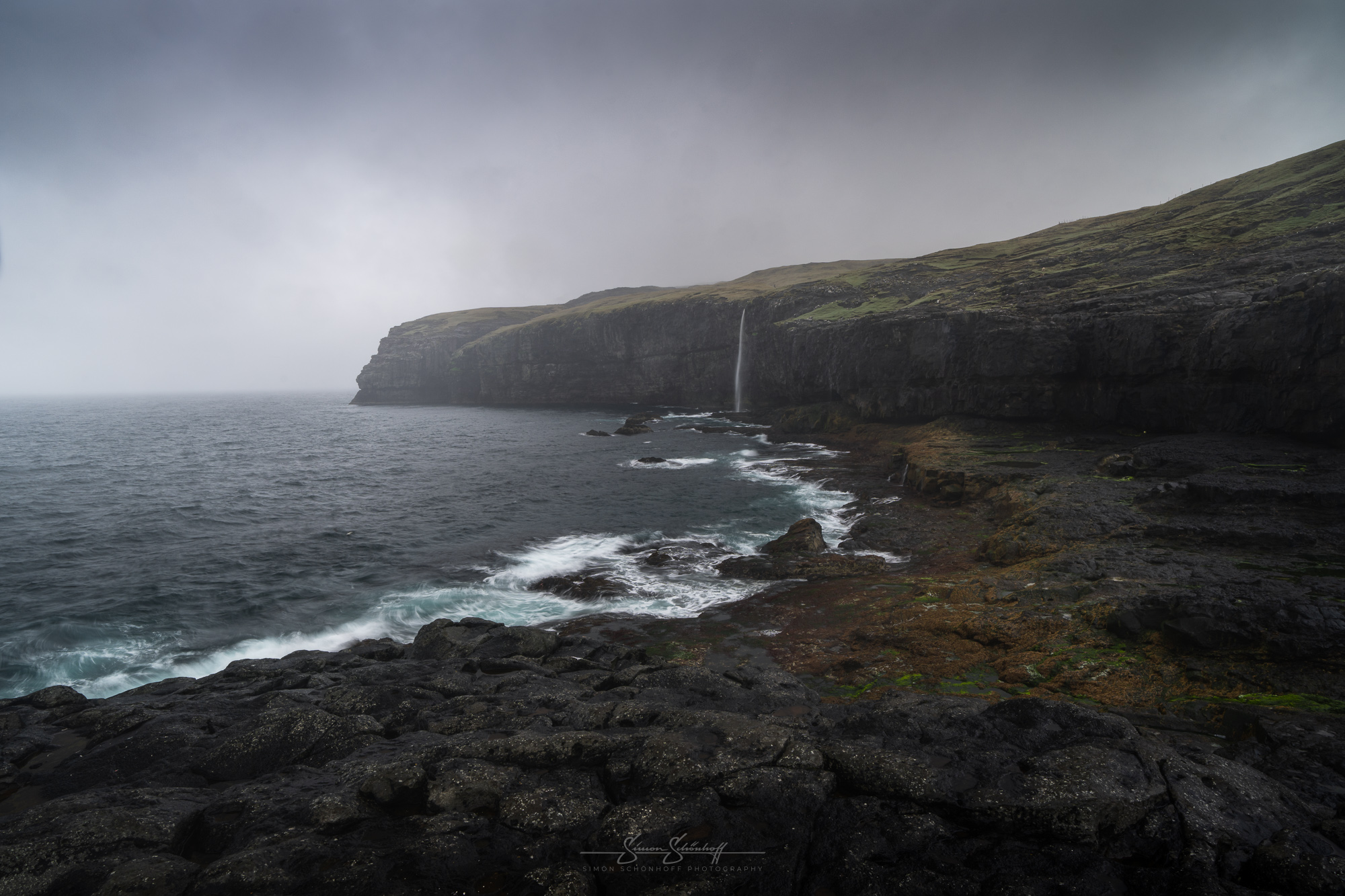
Once we were back in the car, it was time to warm up. But we didn’t have much time for that, as there were only a few minutes’ drive between us and a viewpoint on Risin og Kellingin, which we headed for.
This road to the viewpoint is often closed in the winter months, but is easy to reach in the summer months. Risin og Kellingin, the name of the two rocks means “the giant and the woman”. They are one of the most famous natural monuments on the Faroe Islands. Despite their impressive heights of 71m and 69m, they seem quite small. This is mainly due to their location in front of the cliffs, which are considerably higher at 352m. The view of Eidiskollur, the highest point of the cliffs, was not visible due to the low clouds. Nevertheless, some very atmospheric pictures were taken.
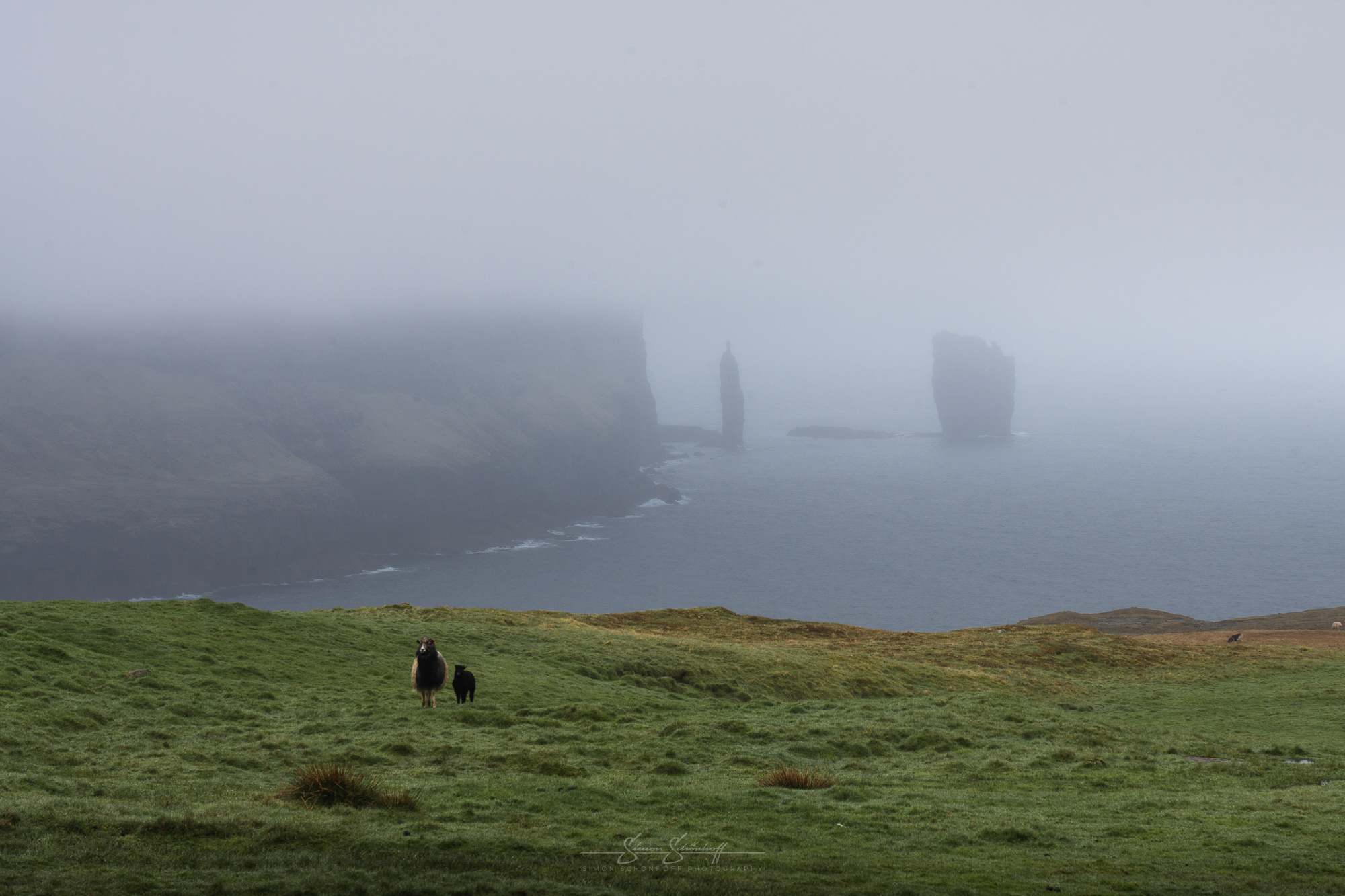
Now, for the first time, the weather put a spanner in the works. As it cleared up much more slowly than the weather forecast had predicted and visibility got even worse, we were unable to go on our planned hike to Slaettarandidur, the highest mountain on the Faroe Islands. We wouldn’t have been able to see anything even from the summit. Another viewpoint of the town of Funningur and the surrounding fjord landscape was not an option in the thick fog.
So we drove on to Gjógv, which literally means by the crevice. The fog that hung in the valleys and mountains of North-Esturoy was not present here, and the rain was also gone. So we were able to enjoy Gjógv a little. We were able to walk along the crevice that used to serve as a harbor. Even the Vikings are said to have used it.
Incidentally, the church in Gjógv is the first church to be consecrated in Faroese, in 1929. Before that, the inhabitants of Gjógv went to Funningur to worship.
From a photographic point of view, it is not easy to photograph the crevice and the location at the same time. Even 16 mm is not really enough. The drone would be an option, but the wind was too strong when we were there. The second option is to take a panorama. But sections and details also make great pictures here in the village.
However, I was a little disappointed after this tour. Because the weather didn’t play along as planned. Because we had a little extra time that day, we simply drove a little further to Elduvík.
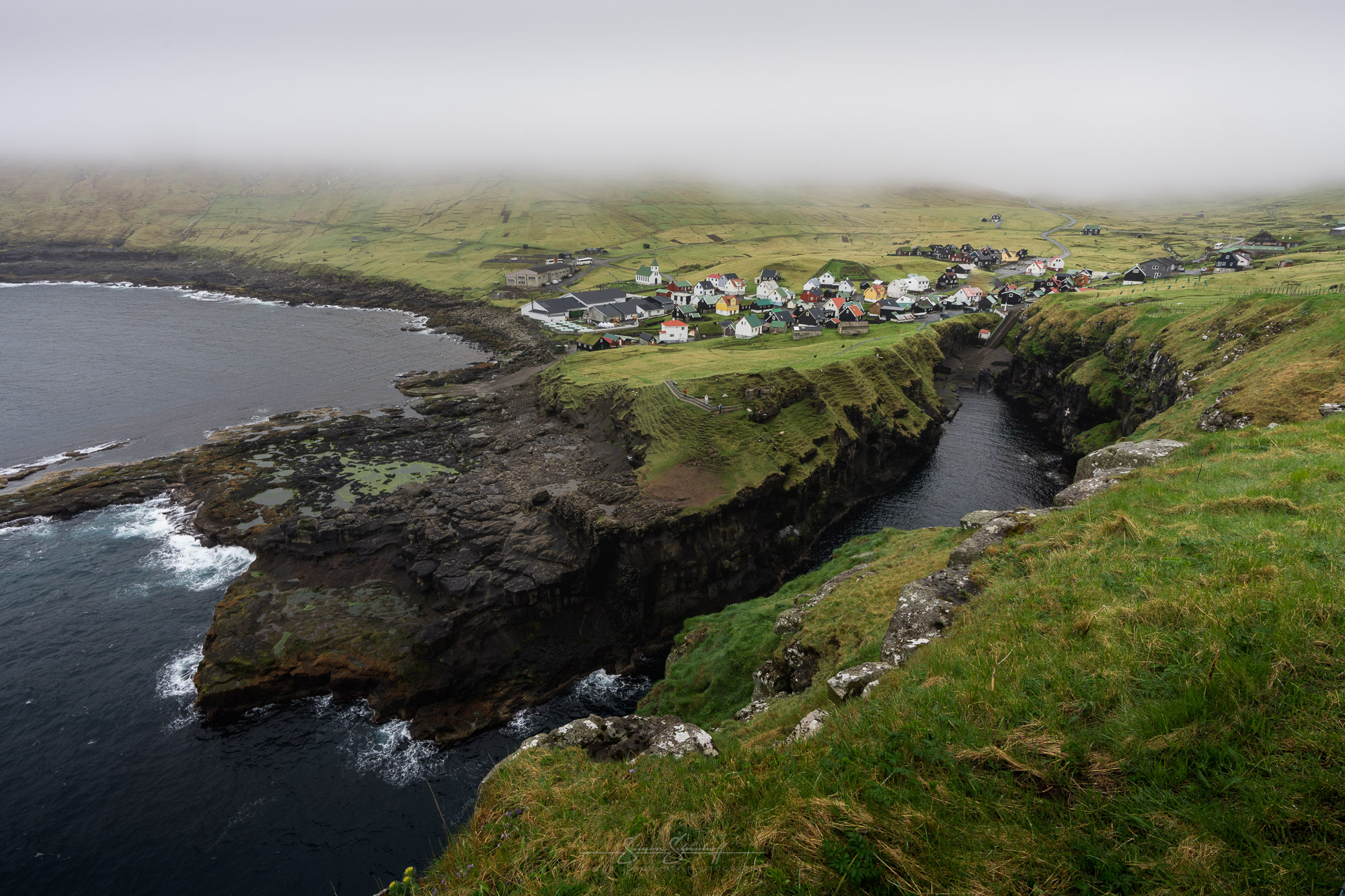
Elduvík is a beautiful little village with a great location on a fjord that opens out to the sea. Here, too, there are typical Faroese houses and a church in the center of the village that can be photographed.
The drive through the fjord landscapes to Elduvík is beautiful from both sides. You should also not miss the route via Oyndarfjørður.
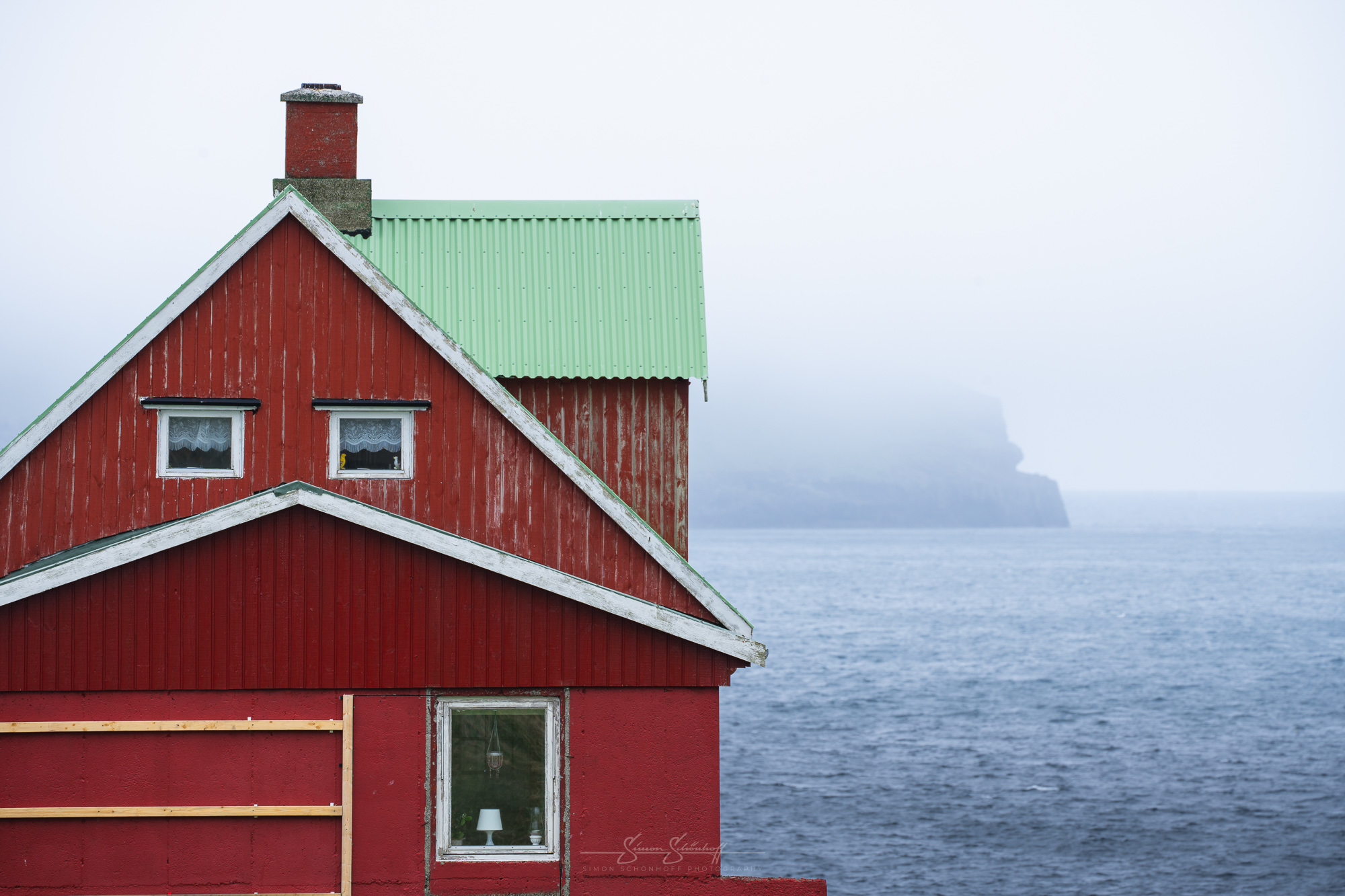
From Elduvík, we drove back to our apartment and made ourselves something to eat, as the plan for the evening wasn’t quite clear yet. On the drive home, I was already thinking: Is the weather bringing me to my knees? Unsuccessful on the Faroe Islands?
I was not entirely pleased with the weather forecast for the evening. Viewfindr showed <10% chance of an evening glow, <50% chance of seeing it. Looking outside, the weather also seemed so discouraging. But staying at home is not an option. The landscape pictures are taken outside, so we decided to hike to Bøsdalafossur tonight. It was the first hike that cost money, 200 DKK per person.
For this price, you get a fantastic view of the inland lake Sørvágsvatn and the slave rock Trælanípa. At the end of the short circular hike on the meadows, there is also a view of the Bødssdalafossur waterfall, which plunges directly from the lake into the sea.
The first viewpoint alone is worth the effort of the hike. Trælanípa, the slave rock from which the Vikings threw the slaves they no longer needed, mostly Irish. The view from a height of 148m vertically into the depths is impressive. From the upper vantage point, then the ideal view of Sørvágsvatn.
We walk across the meadow and rocks along the cliff towards the waterfall. There are no signposts, the path ends where the sea begins. And then we sat there for an hour until sunset. No sun. Flat light. One or two tourists walked past us and probably asked themselves “Are they going to sit here? What are they waiting for in this weather?”
But yes, as long as there is a chance of good light, of a sunset, of a special atmosphere, we will stay put. Just as hope was almost beginning to fade, the sky suddenly exploded. What colors, what an intense sunset. For me, it was one of the most powerful sunsets in recent years.
And it had to be quick. Composition, set polarization, press shutter release, check, correct focus point or focus stacking. And all over again. I took what felt like hundreds of pictures within 30 minutes. The clouds changed quickly and it could have been over at any time. But the sunset lasted a long time.
My ego was saved and the emotions were overflowing. What a brilliant evening. Finally hit the bull’s eye again.
And so we marched back to the starting point through the falling night. Full of anticipation as to what the next few days would bring.
…to be continued…
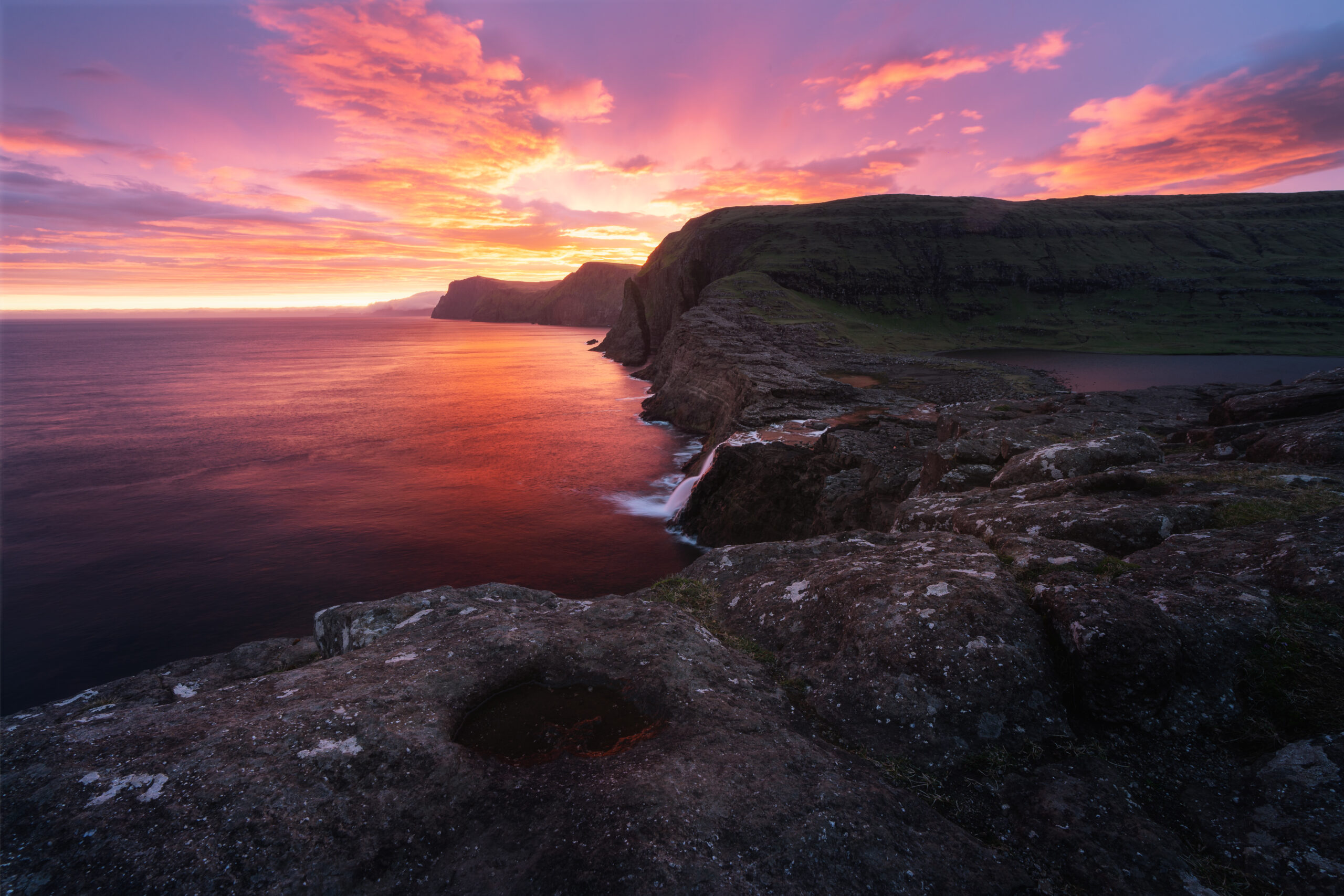
This and all other shots of this post you can request under “Prints” as an art print for your wall at home directly from me.
Die Spannung stieg. Die Koffer sind gepackt, das Foto-Equipment verstaut. Wir sind bereit für die Reise auf die Färöer. Vor dem Zubettgehen noch einmal schnell die Zug- & Flug-Daten checken, dann nochmal für ein paar Stunden aufs Ohr hauen, bevor es wirklich los geht. Ich öffne meine Mails “Ihr Flug wurde storniert”. Was? Das darf doch wohl nicht wahr sein. Steht unsere Reise auf der Kippe? Nach all der Vorbereitung und Planung? Wie wir trotzdem auf die Färöer kamen und was wir in den ersten beiden Tagen dort erlebten, erfahrt ihr in diesem Video. Viel Spaß beim anschauen!
Feel free to share: